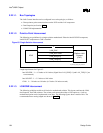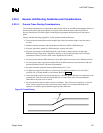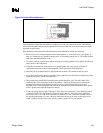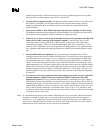
Intel
®
820E Chipset
R
110 Design Guide
2.22.2.3. 4-Layer Board Design
Top-Layer Routing
Sensitive analog signals are routed completely on the top layer without the use of vias. This allows tight
control of signal integrity and removes any impedance inconsistencies due to layer changes.
Ground Plane
A layout split (100 mils) of the ground plane under the magnetics module between the primary and
secondary side of the module is recommended.
Power Plane
Physically separate digital and analog power planes must be provided to prevent digital switching noise
from being coupled into the analog power supply plane’s VDD_A. Analog power may be a metal fill
“island,” separated from digital power, and better filtered than digital power.
Bottom Layer Routing
The digital high-speed signals, which include all LAN interconnect interface signals, are routed on the
bottom layer.
Common Physical Layout Issues
The most common physical layer design and layout mistakes in LAN-on-motherboard designs are as
follows:
1.
Unequal length of the two traces within a differential pair. Inequalities create common-mode
noise which will distort the transmit or receive waveforms.
2.
Lack of symmetry between the two traces within a differential pair. (For each component and/or
via that one trace encounters, the other trace must encounter the same component or a via at the
same distance from the PLC.) Asymmetry can create common-mode noise and distort the
waveforms.
3.
Excessive distance between the PLC and the magnetics or between the magnetics and the RJ-
45/11 connector
. Beyond a total distance of about 4 inches, it can become extremely difficult to
design a spec-compliant LAN product. If they are long, traces on FR4 (fiberglass epoxy substrate)
will attenuate the analog signals. Also, longer traces will increase the impedance mismatch (see
mistake 9). The magnetics should be as close to the connector as possible (<= 1 inch).
4.
Routing any other trace parallel to and close to one of the differential traces. Crosstalk on the
receive channel will degrade the long-cable BER. Crosstalk on the transmit channel can cause
excessive emissions—resulting in FCC test failure—and can result in a low transmission BER on
long cables. Other signals should be kept at least 0.3 inch from the differential traces.
5.
Routing the transmit differential traces next to the receive differential traces. The transmit
trace closest to a receive trace will induce more crosstalk on the closest receive trace, and it can
greatly degrade the receiver’s BER over long cables. After exiting the PLC, the transmit traces


















